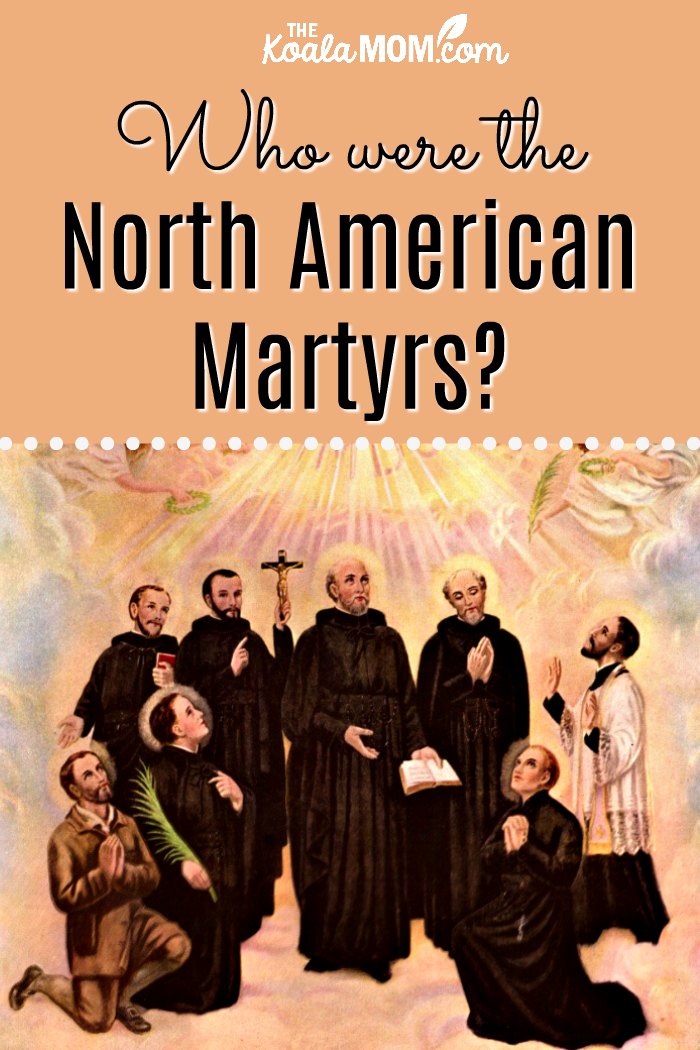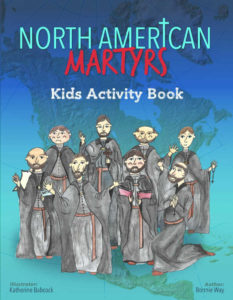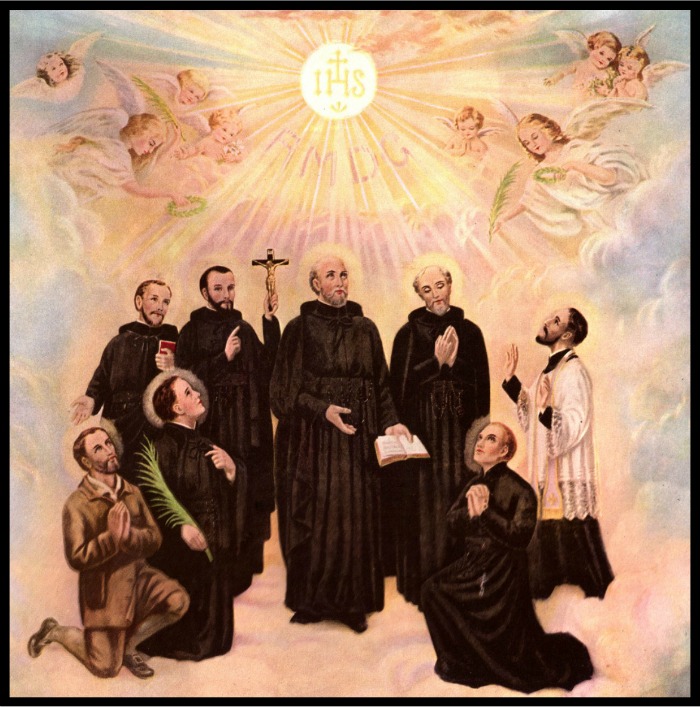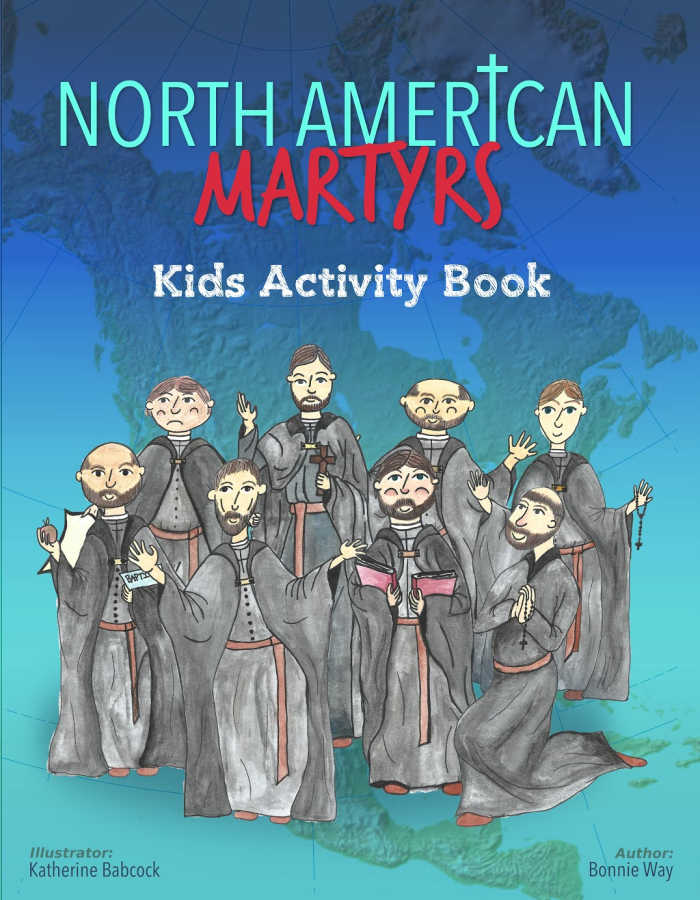In the 1600s, eight Jesuit missionaries gave their lives to spread the Gospel among the Natives of North America. These men are now honoured as the North American Martyrs or the Canadian Martyrs. All were born in France; six were priests and two were laymen; and all died at the hands of the Iroquois. Who were these men, and what did they do?

The Beginnings of the Mission
In 1497, John Cabot was the first European to visit the shores of Canada. He was followed in 1534 by Jacques Cartier, who sailed into the St. Lawrence River on the feast of St. Lawrence and so named it.
The following year, Cartier planted a flag at Quebec and claimed the land for France. He returned to France with many stories, but no gold or jewels.
In 1603, Samuel de Champlain arrived in North America. He established the first French colony at Port Royal the following year. In 1608, he founded another colony at Quebec.
A fervent Catholic, he realized the peoples of North America needed to hear the Gospel. He sent a request to the Franciscan Recollets for missionaries.
In 1615, the first Recollet missionary arrived in Huron country and celebrated Mass. For the next ten years, he and his brothers worked among the Hurons. Realizing that the work was too much for them, they invited the Jesuits to help.
In 1625, the Jesuits sent Father Jean de Brebeuf and two other priests to New France. They were later joined by other missionaries, including those who would become the North American Martyrs.
In Saints of the American Wilderness, John O’Brien notes that “until his death in 1635, Champlain worked unceasingly to develop Canada as a colony, to promote the fur trade, to explore the interior, and to evangelize the Indians.” He explored the St. Lawrence River and reached the Great Lakes. He allied himself with the Hurons, the first Native Americans he met, and thus made enemies with the Iroquois, their enemies.
Missionary Life in New France
 New France at this time covered the areas now known as Nova Scotia, Prince Edward Island, New Brunswick, Quebec, Ontario, Maine and New York. Quebec was the centre; here was the hospital, the ships bringing supplies from New France, the other French settlers.
New France at this time covered the areas now known as Nova Scotia, Prince Edward Island, New Brunswick, Quebec, Ontario, Maine and New York. Quebec was the centre; here was the hospital, the ships bringing supplies from New France, the other French settlers.
The Hurons lived around the Great Lakes, a journey of several weeksdown the St. Lawrence River by canoe. The Iroquois lived in the areas of Maine and New York. They traded with the Dutch. Having depleted their own areas of furs, they pressed into the Huron territory for more. By 1649, they would completely destroy the Huron nation and Jesuit missions.
Life among the Hurons was radically different than life in France. The priests sought to live with the Hurons, eating, sleeping and hunting as the Hurons did. Some picked up the language quickly; others struggled. They made friends slowly, for the Hurons found the ways of the newcomers just as strange as the priests found the ways of the Hurons.
The Hurons viewed the chalice, rosary, and other holy items as “magic” items, similar to those used by their own medicine men. The arrival of Europeans had brought the smallpox to North America. This disease devastated the Hurons, killing one in three and leaving them scared and angry. They blamed the “black robes.”
Despite this, the Jesuits worked tirelessly to make friends and earn the trust of the Hurons. They cared for the sick, shared their food, prayed. They were not here for a few years before returning to France. All of the North American Martyrs, as well as the other priests who served with them, spent most of their lives serving God in New France.
Saint Rene Goupil
Saint René Goupil was born in 1608 and the first to be martyred in 1642. He wished to become a Jesuit, but was turned away because he suffered poor health. He travelled to New France and studied medicine in the hospitals there.
In 1642, he was accompanying St. Isaac Jogues from Quebec to the mission when they were captured by Iroquois. They were tortured along the way to Ossernenon, the Iroquois village. There, St. Rene was killed for making the sign of the cross over a child.
Through his tireless ministry to the sick, Rene Goupil had won the esteem and affection of both the French and the Indians. When he was invited to embark with Jogues, being reminded of the dangers in store for him, he accepted instantly and with the same humble generosity that had endeared him to all at Quebec. ~ John A. O’Brien, Saints of the American Wilderness
Saint Isaac Jogues
Saint Isaac Jogues was born in 1608and martyred in 1646. He arrived in New France in 1636 and served with St. Jean de Brebeuf and St. Antoine Daniel. He was captured by the Iroquois with St. Rene Goupil in 1642. They were tortured by the Iroquois, who bit off St. Isaac’s fingers and pulled out his fingernails. He then spent a year in captivity before escaping with the help of Dutch traders.
He was hailed as a hero in France, met the queen, and received special compensation to continue celebrating Mass despite his mangled hands. He returned to New France and spent two years in Quebec. Because he knew the Iroquois language, he desired to preach to them and set out on a peace mission with St. Jean de Lalande in 1646. He was again captured and martyred with St. Jean.
We must always seek to accommodate our desires to the desires of the divine Goodness, which can only be very sacred and highly respected by us, since they come from a heart most desirous of our good. ~ St. Isaac Jogues, in a letter to his mother, 1636
St. Jean de Lalande
Saint Jean de Lalande was martyred in 1646 with St. Isaac Jogues. He served with the Jesuits as a layperson or donne in New France. He accompanied St. Isaac on a mission to the Iroquois and was captured with him. After Jogues’ death, he attempted to recover the priest’s body and was killed.
St. Jean de Brebeuf
Saint Jean de Brébeuf was born in 1593 and martyred in 1649. He was one of the first Jesuits to arrive in New France in 1626. Like some of the other North American Martyrs, he faced ill health (likely tuberculosis), which cleared up when he reached New France.
He had a sabbatical in France from 1629 to 1633, when New France became under English control. With St. Antoine Daniel, he started a new mission in Huronia in 1633. He served for a time as Superior of the missions, and later worked in Quebec, coordinating supplies to the missions. He wrote a Huron dictionary and grammar, as well as the popular Huron Christmas Carol.
He was killed in 1649 with St. Gabriel Lalemant when their mission was attacked by Iroquois.
We must have a sincere affection for [these people], looking upon them as ransomed by the Blood of the Son of God and as our brother, with whom we are to spend the rest of our lives. ~ St. Jean de Brebeuf, in “Instructions for the Fathers of Our Society Who Will Be Sent to the Hurons”
St. Gabriel Lalemant
Saint Gabriel Lalemant was born in 1610 and martyred in 1649. His uncles, Jerome and Charles Lalemant, were also Jesuit priests and missionaries to New France. He followed their example, becoming a priest in 1630 and vowing to spend his life serving the Natives of North America.
He waited over a decade to fulfill that vow. Because of his poor health, his superiors kept him in France. Finally, in 1646, he was sent to the missions. He spent two years in Quebec before joining St. Jean de Brebeuf in the Huron missions. He was there for only 6 months before the Iroquois attacked. St. Jean and St. Gabriel were tortured and killed soon after.
… my God, my Savior; … if you abandoned your contentments, your honors, your comforts your joys, and your life, in order to save me, wretched one,—is it more than reasonable that I abandon, after your example, all these things for the salvation of souls… ~ St. Gabriel Lalemant
St. Charles Garnier
Saint Charles Garnier was born in 1606 and martyred in 1649. He joined the Jesuits in 1624, along with three friends, and taught at a Jesuit college before being ordained in 1635. The following year, he arrived in Quebec to minister to the Hurons.
His cheerfulness and beardless face made him popular with the Hurons. He had a gift for ministering to the sick. He established a successful mission to the Petuns, neighbours of the Hurons. Even when the mission was attacked on December 7 and he was wounded, he continued to baptize neophytes and to assist a wounded Hurons.
St. Antoine Daniel
Saint Antoine Daniel was born in 1600 and martyred in 1648. He became a Jesuit in 1621 and arrived in Port Royal in 1632, then went to Quebec. He had a gift for teaching and was popular with children because of his gentleness and cheerfulness.
In 1635, his superiors asked him to start the first boy’s college in North America in Quebec in 1635. It wasn’t successful, though two of his students became model Catholics. He returned to the missions and spent seven years serving there before being killed when the Iroquois attacked.
St. Noel Chabanel
Saint Noel Chabanel was born in 1613 in France and martyred in 1649. Of all the North American Marytrs, he had the hardest time adjusting to the lifestyle of the Hurons and learning their language. The change of diet, the smoke of the fires, and the crowded living conditions affected him negatively. He suffered depression, questioning whether he had misunderstood God’s call to him.
On the Feast of Corpus Christi in 1647, he made a vow to remain in the Huron missions until death. While nothing else about his circumstances changed, this vow seems to have alleviated his mental sufferings. He wrote about his lack of fear to a friend, and told his brother that he would make himself a “martyr to my nature, a matyr without bloodshed.”
St. Noel was sent to help St. Charles Garnier with the Petuns. However, when they were warned that the Iroquois were attacking, St. Charles sent St. Noel away. St. Charles was killed the next day by the Iroquois. The cause of St. Noel’s death is unknown. He may have gotten lost and starved, drowned, or been killed by a Huron or Iroquois warrior.

Legacy of the North American Martyrs
By the end of 1649, the Jesuit missions were destroyed and the Hurons scattered. Eight of the Jesuit missionaries were dead. It would have seemed that all the work of the past two and a half decades was wasted. The fierce Iroquois had accomplished their goal of destroying the Hurons and their French allies.
It is times of hardship, however, that faith thrives. Many of the scattered Hurons carried their beliefs with them to their new homes among other tribes. The Jesuits and some of the Hurons retreated to Quebec. And in Ossernenon, where St. Isaac, St. Rene and St. Jean de Lalande were martyred, a girl named Kateri Tekakwitha was born.
The North American Martyrs were canonized in 1930. They are the patron saints of Canada. Their feast day is celebrated on October 19 in the US and September 26 in Canada.
The Lives of the North American Martyrs for kids
Help your children grow in their faith through the lives of the North American Martyrs. The North American Martyrs’ Kids Activity Book has 135 pages of stories, crosswords, word searches, mazes, reflection questions, and other activities. Your children will learn from the examples of St. Charles Garnier, St. Jean de Brebeuf, St. Isaac Jogues, St. Rene Goupil, St. Antoine Daniel, St. Noel Chabanel, and St. Jean de Lalande and draw closer to God. Buy on Amazon!


No Responses Yet